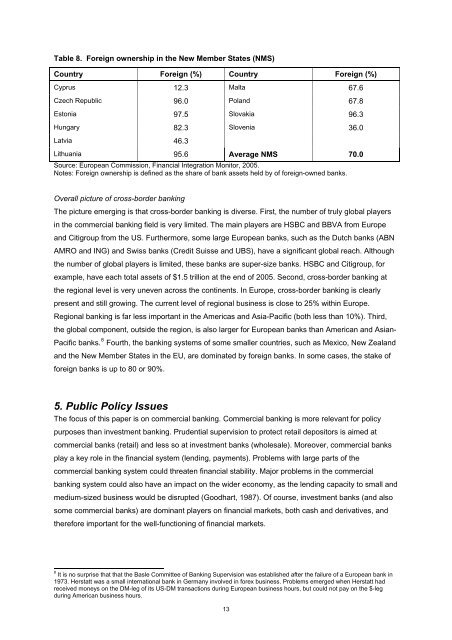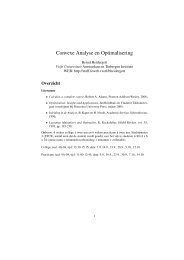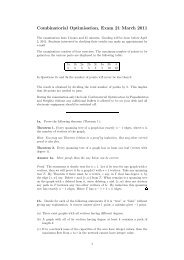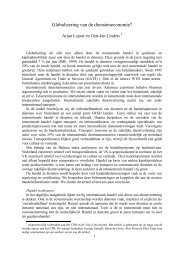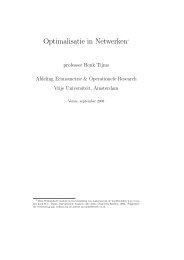Current State of Cross-Border Banking - Vrije Universiteit Amsterdam
Current State of Cross-Border Banking - Vrije Universiteit Amsterdam
Current State of Cross-Border Banking - Vrije Universiteit Amsterdam
You also want an ePaper? Increase the reach of your titles
YUMPU automatically turns print PDFs into web optimized ePapers that Google loves.
Table 8. Foreign ownership in the New Member <strong>State</strong>s (NMS)<br />
Country Foreign (%) Country Foreign (%)<br />
Cyprus 12.3 Malta 67.6<br />
Czech Republic 96.0 Poland 67.8<br />
Estonia 97.5 Slovakia 96.3<br />
Hungary 82.3 Slovenia 36.0<br />
Latvia 46.3<br />
Lithuania 95.6 Average NMS 70.0<br />
Source: European Commission, Financial Integration Monitor, 2005.<br />
Notes: Foreign ownership is defined as the share <strong>of</strong> bank assets held by <strong>of</strong> foreign-owned banks.<br />
Overall picture <strong>of</strong> cross-border banking<br />
The picture emerging is that cross-border banking is diverse. First, the number <strong>of</strong> truly global players<br />
in the commercial banking field is very limited. The main players are HSBC and BBVA from Europe<br />
and Citigroup from the US. Furthermore, some large European banks, such as the Dutch banks (ABN<br />
AMRO and ING) and Swiss banks (Credit Suisse and UBS), have a significant global reach. Although<br />
the number <strong>of</strong> global players is limited, these banks are super-size banks. HSBC and Citigroup, for<br />
example, have each total assets <strong>of</strong> $1.5 trillion at the end <strong>of</strong> 2005. Second, cross-border banking at<br />
the regional level is very uneven across the continents. In Europe, cross-border banking is clearly<br />
present and still growing. The current level <strong>of</strong> regional business is close to 25% within Europe.<br />
Regional banking is far less important in the Americas and Asia-Pacific (both less than 10%). Third,<br />
the global component, outside the region, is also larger for European banks than American and Asian-<br />
Pacific banks. 8 Fourth, the banking systems <strong>of</strong> some smaller countries, such as Mexico, New Zealand<br />
and the New Member <strong>State</strong>s in the EU, are dominated by foreign banks. In some cases, the stake <strong>of</strong><br />
foreign banks is up to 80 or 90%.<br />
5. Public Policy Issues<br />
The focus <strong>of</strong> this paper is on commercial banking. Commercial banking is more relevant for policy<br />
purposes than investment banking. Prudential supervision to protect retail depositors is aimed at<br />
commercial banks (retail) and less so at investment banks (wholesale). Moreover, commercial banks<br />
play a key role in the financial system (lending, payments). Problems with large parts <strong>of</strong> the<br />
commercial banking system could threaten financial stability. Major problems in the commercial<br />
banking system could also have an impact on the wider economy, as the lending capacity to small and<br />
medium-sized business would be disrupted (Goodhart, 1987). Of course, investment banks (and also<br />
some commercial banks) are dominant players on financial markets, both cash and derivatives, and<br />
therefore important for the well-functioning <strong>of</strong> financial markets.<br />
8 It is no surprise that that the Basle Committee <strong>of</strong> <strong>Banking</strong> Supervision was established after the failure <strong>of</strong> a European bank in<br />
1973. Herstatt was a small international bank in Germany involved in forex business. Problems emerged when Herstatt had<br />
received moneys on the DM-leg <strong>of</strong> its US-DM transactions during European business hours, but could not pay on the $-leg<br />
during American business hours.<br />
13


